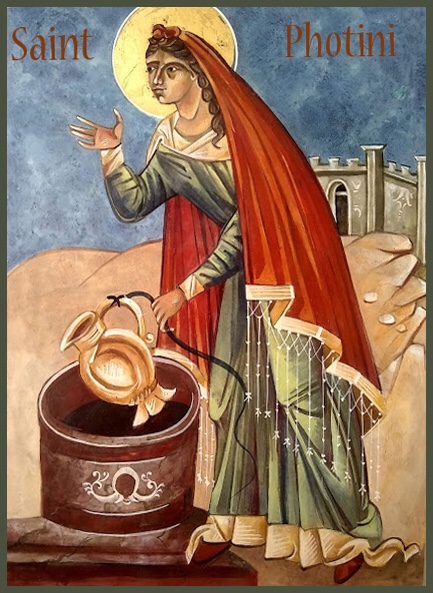Recently, I reflected on the story of Jesus and his encounter with the woman by the well in Samaria (John 4). See https://johntsquires.com/2020/03/10/the-pharisee-of-jerusalem-and-the-woman-of-samaria-john-3-and-4/
There is a wonderful classic picture of this scene, drawn by the 19th century French artist, James Tissot.

https://www.brooklynmuseum.org/opencollection/objects/4469
In contrasting this story (in the open, in broad daylight) with the previous story of Jesus and his encounter with a Pharisee of Jerusalem (indoors, in the dark of night), I noted that we know the name of the Pharisee—Nicodemus—but the woman remains anonymous, without a name.
The tradition of the church, as it has evolved over the years, has named this woman, and even canonised her: in Eastern Orthodox churches, she is Saint Photini. The name is derived from the Greek term for “enlightenment”. By tradition, Saint Photini is dressed in red, as the pictures in this post demonstrate.

This name encapsulates the key dynamic of the story recounted in John 4. The woman moves from a (seemingly) chance encounter with Jesus, to become fully aware (enlightened) as to his status: he is prophet, Messiah, and (in the words of the people to whom she subsequently testifies), Saviour of the world.
Because of the last section of the scene beside the well, as told in the book of origins (John 4:27), the witnessing that the woman made to the people of her city (4:28-30, 39), and the resulting confession of Jesus as Saviour of the world (4:40-42), the woman was honoured in the preaching of church fathers as an evangelist, alongside the better-known apostolic figures (largely male).

As the Christian tradition evolved, more was claimed about this woman. She, along with her five sisters and two sons, were baptised. It is at this point, according to tradition, that she adopted the Christian name of Photini. The Russian Church, which also remembers her in the equivalent Russian name Svetlana, has honoured her in this hymn:
By the well of Jacob, O holy one,
thou didst find the Water of eternal and blessed life;
and having partaken thereof, O wise Photina,
thou wentest forth proclaiming Christ, the Anointed One.
(Megalynarion for St. Photina, according to the Byzantine usage.)

The developing traditions about Photini in the Byazantine period placed her, at one point in her life, in Carthage in North Africa, where she converted many people. Hearing the news of the persecution of believers in Rome under Nero, Photini and many of her converts sailed to Rome, where she witnessed to her faith as she stood before the Emperor. Nero had her and her family beaten and imprisoned.
Nero then sent his daughter, Domnina, to speak with Photini. As a result, Domnina was converted, baptised, and adopted the name Anthousa. Nero tried many ways to punish Photini, Anthousa, and their group, but the spirit enabled them to resist them all. Eventually, so the story goes, Photini have her life over to God, who called her to her heavenly reward.
Since then, generations of Orthodox Christians have prayed to this saint in these words:
Illuminated by the Holy Spirit, All-Glorious One,
from Christ the Saviour you drank the water of salvation.
With open hand you give it to those who thirst.
Great-Martyr Photini, Equal-to-the-Apostles,
pray to Christ for the salvation of our souls.
On the Greek Calendar, Saint Photina is commemorated on February 26.
I have summarised the above from
http://www.orthodoxchristian.info/pages/photini.htm

So many of the women in the Bible are known to us only in passing. Many of them, like the woman of Samaria, are accorded no name at all. There are many women in the Bible who are identified by their relationship with a named man (the wife of Noah, the daughter of Jephthah, the mother of Sisera, the wife of Job, the daughter of Jairus, or the daughters of Philip, for instance) or by their geographic location (the Shunnamite woman, the witch of Endor, the woman of Tekoa, the Queen of Sheba, the widow of Nain, and so on). Even the sisters of Jesus (unlike some of his brothers, James and Jude) remain nameless in the New Testament.
See the full list at https://www.biblegateway.com/resources/all-women-bible/Chapter-3-Nameless-Bible-Women
The tradition has sought to rectify the anonymity of the woman of Samaria in this instance. She has become Photini. Let us honour her for he pathway towards enlightenment, the full understanding of who Jesus is, and the wholehearted practice of discipleship, as evangelist, in her life. This, to be sure, is consistent with the story told in John 4.

See also


5 thoughts on “From the woman at the well to a Byzantine saint: John 4, St Photini, and the path to enlightenment (Lent 3A)”